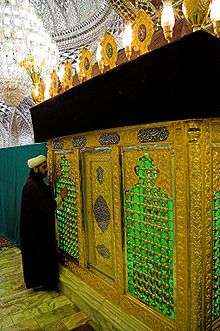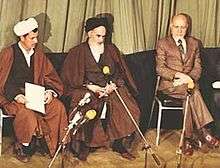Mullah
Mullah (/ˈmʌlə, ˈmʊlə, ˈmuːlə/; Arabic: ملا) is derived from the Arabic word mawlā, meaning "vicar", "master" and "guardian". However, since this word is used ambiguously in the Quran, some publishers have described its usage as a religious title as inappropriate.[1] The term is sometimes applied to a Muslim man, educated in Islamic theology and sacred law. In large parts of the Muslim world, particularly Iran, Pakistan, Azerbaijan, Afghanistan, Eastern Arabia, Turkey and the Balkans, Central Asia, the Horn of Africa and other parts of the Indian subcontinent, it is the name commonly given to local Islamic clerics or mosque leaders.[2]

The title has also been used in some Sephardic Jewish communities to refer to the community's leadership, especially religious leadership.[3]
Mullah and its variation Mulla have also degenerated into a derogatory term for a Muslim priest,[4][5][6][7][8][9] that connotes a semiliterate, backward, often bigoted village imam.[10] "Although, interestingly enough, the holy Quran stridently denounces priesthood (and this would include mullah-hood, too), the mullahs act virtually as priests, and presume it to be their sole prerogative to interpret Islam."[11]
Training and duties
Ideally, a trained mullah will have studied Islamic traditions (hadith), and Islamic law (fiqh). Such figures often have memorized the Qur'an. Uneducated villagers may frequently classify a literate Muslim with a less than complete Islamic training as their "mullah" or religious cleric. Mullahs with varying levels of training lead prayers in mosques, deliver religious sermons, and perform religious ceremonies such as birth rites and funeral services. They also often teach in a type of Islamic school known as a madrasah. Three kinds of knowledge are applied most frequently in interpreting Islamic texts (i.e. the Quran, Hadiths, etc.) for matters of Shariah, i.e., Islamic law.
Mullahs have frequently been involved in politics, but only recently have they served in positions of power, since Islamists seized power in Iran in 1979. In Syria, political militant groups supported by the West have taken root. The Taliban enforced Islamism in Afghanistan.(source?)
Usage
The term is most often applied to Shi'ite clerics, as Shi'a Islam is the predominant tradition in Iran. However, the term is very common in Urdu, spoken throughout Pakistan, and it is used throughout the Indian subcontinent for any Muslim clergy, Sunni or Shi'a. Muslim clergy in Russia and other former Soviet Republics are also referred to as mullahs, regardless of whether they are Sunni or Shi'a.
The term has also been used among Persian Jews, Bukharan Jews, Afghan Jews, and other Central Asian Jews to refer to the community's religious and/or secular leadership. In Kaifeng, China, the historic Chinese Jews who managed the synagogue were called "mullahs".[12]
Outside of Eastern Arabia, which has a long Shiite tradition and numerous Shiite minorities, the term is seldom used in other Arabic-speaking areas where its nearest equivalent is often shaykh (implying formal Islamic training), imam (prayer leader; not to be confused with the imams of the Shiite world), or ʿālim ("scholar", plural ʿulamāʾ). In the Sunni world, the concept of "cleric" is of limited usefulness, as authority in the religious system is relatively decentralized.
The term is frequently used in English, although English-speaking Muslim clergy rarely call themselves mullahs. It was adopted from Urdu by the British rulers of India and subsequently came into more widespread use.
It is sometimes used in a derogatory and humorous form, to mock gnostically religious men.
Iran
Until the early 20th century, the term mullah was used in Iranian hawzas (seminaries) to refer to low-level clergy who specialized in telling stories of Ashura, rather than teaching or issuing fatwas. In recent years, at least among Shia clerics, the term ruhani (spiritual) has been promoted as an alternative to mullah and akhoond, free of pejorative connotations.[13]
Dress

In Iran the usual dress of a mollah is a turban (Persian: عمامه ammāme), a long coat with sleeves and buttons, similar to a cassock (Persian: قبا qabā), and a long gown or cloak, open at the front (Persian: عبا abā). The aba is usually made either of brown wool or of black muslin. It is sleeveless but has holes through which the arms may be inserted. The turban is usually white, but those who claim descent from the Prophet Muhammad traditionally wear a black turban.[14]
References

- Esposito, John (2004). The Oxford Dictionary of Islam. p. 214.
- Roy, Olivier (1994). The Failure of Political Islam. Cambridge, Massachusetts: Harvard University Press. pp. 28–9. ISBN 0-674-29140-9.
- See for example: "Rabbinic Succession in Bukhara 1790–1930",
- Sai Felicia Krishna-Hensel, Authoritarian and Populist Influences in the New Media
- 1995, Religion and Society, Volume 42, Page 23.
- Salman Shami, 2017, The Blasphemy Law.
- Jeff Sahadeo, 2007, Russian Colonial Society in Tashkent1865--1923, Page 196-197.
- Moinuddin Ahmed, 1990, Ulamā: the boon and bane of Islamic society, Page 89.
- Pakistan Journal of History and Culture, Volumes 4-5, Page 25.
- 1975, Area Handbook for Bangladesh, Page 117.
- And Now The Mullahs, Outlook, 14 January 2011.
- Chinese and Japanese repository of facts and events in science, history and art, relating to Eastern Asia, Volume 1. Oxford: s.n. 1863. p. 48. Retrieved 2011-07-06. (Original from the University of Michigan)
- Momen, Moojan, An Introduction to Shi'i Islam, Yale University Press, 1985, p. 203
- Seyyed Behzad Sa'adati-Nik Tarīkhche-ye Lebās-e Rūhānīat (The History of Clerical Dress). Mehr News, 29 Tir 1394.
External links
- . New International Encyclopedia. 1905.
- International Imam Organization